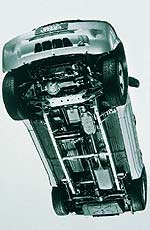
Driveline Diagnosis and Repairs.
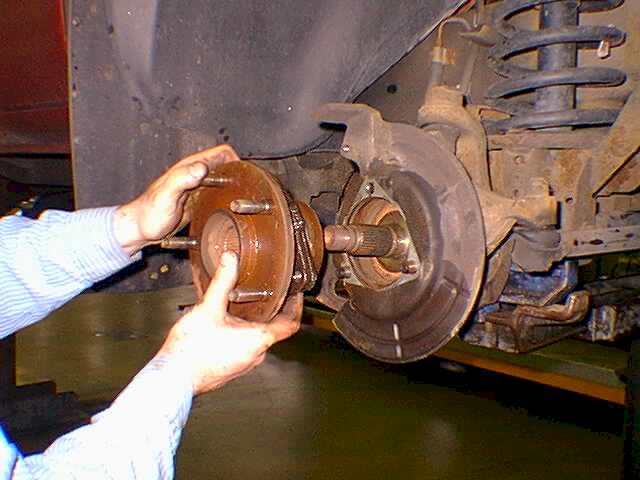
Here is a view of a front hub being removed.
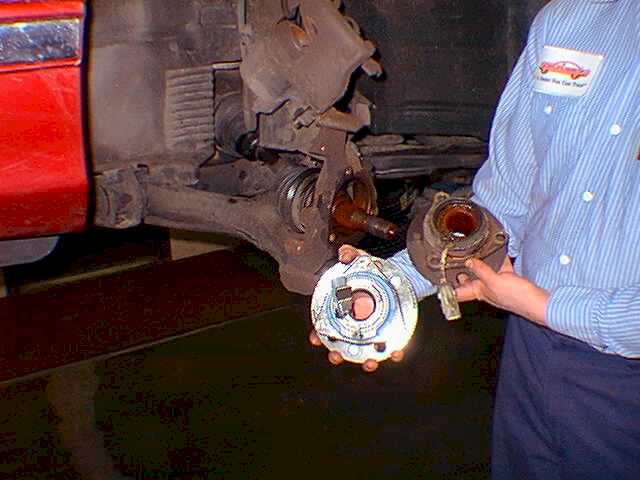
Comparing a failed hub with a new one, notice the ABS sensor wire
on this Cadillac hub.
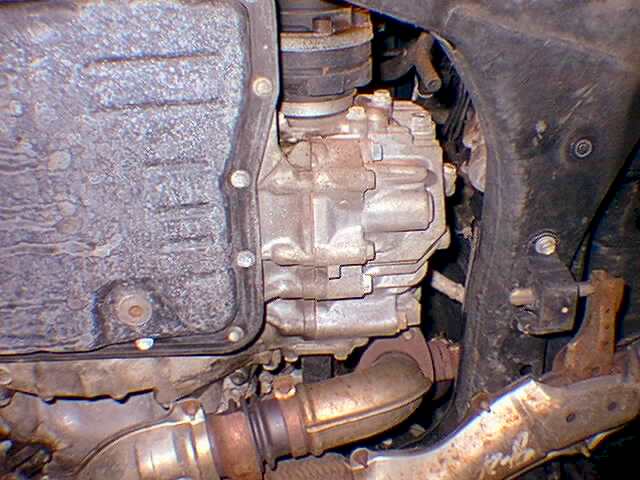
A View of a differential. Check the service manual to see if the car
you are working on has a separate differential fluid chamber with its own
inspection plug. This is easy to overlook.
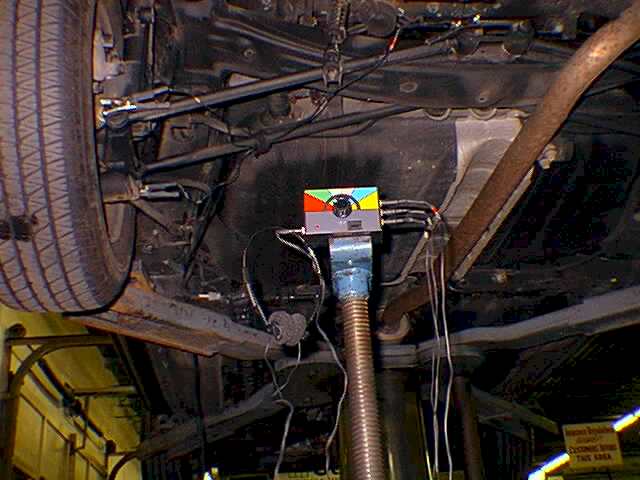
Here is an example of a listening device with 4 separate leads that
can be clamped to various items under the car. While the vehicle is in motion
another technician riding shotgun can wear the headset and dial-in each of
the four sensor leads, one at a time, to localize a noisy component.
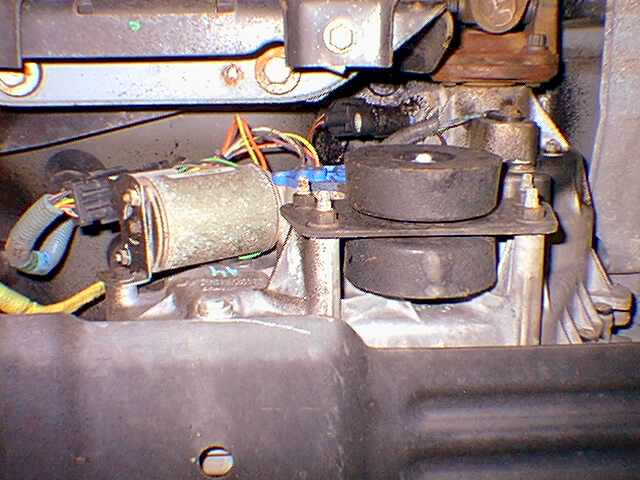
Electric motor style four wheel drive unit that eliminates the need
for a four wheel shift lever in the cabin. These motors can fail rendering
the four wheel drive system inoperable.
|
Driveline Diagnosis And Repairs.
For technicians who do not mind getting their hands dirty and doing
a little detective work, driveline service can be rewarding and profitable.
While most of us are familiar with basic driveline service, it can be helpful
to look at common problems and even
common service mistakes. Driveline service is still one area where you can
be successful without a large investment in tools and equipment.
First things first.
Often the most difficult part of driveline service is communication.
Like any automotive service, good communication can be the key to a profitable
job and a happy customer. The first step, as in any service, is to obtain
as much information as possible from the
customer. Don't jump to conclusions just because you have seen the same
symptoms a dozen times in the past. If at all possible, take a road test
with the customer and try to duplicate the complaint. For the most part,
trying to repair a noise from just a customer's explanation can be asking
for trouble; their definition of 'odd' sounds cannot be as reliable as that
of a seasoned technician's. Once you have obtained all the information you
can from the customer, it is time to see what can be learned from the vehicle
itself.
If you are seeing this vehicle for the very first time, take a few
minutes to look the car over in general. Does it look like it receives regular
maintenance? Does it have a tow hitch rated for more than it could ever
safely tow? Is the vehicle rustier than normal or have unusually high
mileage for its age? All these things can give you valuable information on
how the vehicle is used and what caused the component failure.
After you have diagnosed the vehicle and you're ready to call the
customer with your recommendations, remember anything left unsaid leaves an
opening for communication problems and assumptions. If, for example, you were
going to replace a leaking axle seal, this would be the time to tell the
customer he has other unrelated fluid leaks that you are not diagnosing or
correcting at this time. After the repair -- when the customer calls to say
something is still leaking -- it's too late! Make the customer clearly aware
of any obvious problems you noticed, the then separate cost for the diagnosis
and the total cost of the repair with parts and labor. Of course, you also
can recommend related service or repair especially if it will save the customer
money or prevent a breakdown in the near future.
Universal joints.
Drive shaft service on rear-wheel drive and four-wheel drive vehicles
is pretty much limited to universal joint (U-joint) replacement for most
shops. This does not mean everything else should be ignored, however. Driveshaft
problems have two distinct symptoms that can make diagnosis easy. While
tire balance problems are speed sensitive, driveshaft vibrations are not.
A binding U-joint or damaged driveshaft will make a vibration that will shake
the floor of the vehicle. While high speed can make it worse, it will be
present at most speeds. A severely damaged U-joint can make a repeated 'chirping'
or squeak at very low speeds. On many four-wheel drive vehicles the front
drive shaft does not spin in two-wheel drive, so a complaint when in four-wheel
drive would be the only reason to suspect a front driveshaft problem. The
best way to check the U-joints for binding is simply to remove the driveshaft
and feel how easily they can be rotated in both directions by hand. Don't
forget that a dented driveshaft or a weight knocked off balance can create
the same vibrations as a binding U-joint.
The style of the bearing cup retention must be determined before
U-joint service. Besides internal and external snap ring -- or 'c' -- clips,
some OEM U-joints are secured with an injected nylon ring. This type of retainer
is simply sheared off when the bearing cup is pressed out of the yoke. Nylon
injected U-joints can not be reassembled once removed. When installing a new
U-joint with a grease fitting, it is best to locate the fitting where it
will be under compression and not tension because this is the weakest part
of the joint. If the slip joint is separated for service, it must be marked
to keep the relationship between front and rear U-joints the same. On modified
vehicles, the operating angle of both U-joints need to be equal so they can
balance out the inherent speed changes when they rotate at an angle.
Drive axles.
While many shops do not offer complete differential service, solid
drive axles still offer some opportunities for general service. Outer axle
seal replacement is pretty straightforward and easy to diagnose. Just remember
that brake linings contaminated with gear oil will need to be replaced.
Diagnosing drive axle noises can be a little more challenging. For
the most part, outer wheel bearing noises can be verified by steering left
and right while driving, rocking the vehicle to move the weight more left
and right. Bearing noise that is noticeably worse in one direction indicates
the opposite outer wheel bearing is at fault. In other words, noise on a
left turn indicates a problem in the right side bearing and vice versa. Inner
differential bearing noises are not affected by vehicle sway; their noise
is constant and varies with vehicle speed. Gear-related noises are usually
more noticeable at one speed, and the noise can be changed by varying the
driveline load between accelerating and coasting. Most inner differential
problems are the result of a lack of lubrication. With all the attention
paid to saving time during regular maintenance, some shops do not inspect
the differential fluid level or may even fail to realize many front-wheel
drive vehicles have separate differential fluids.
On four-wheel drive vehicles, winter use can provide more opportunities
for service. Manual hubs and manual four-wheel drive actuation are becoming
less common, so diagnosis should start with a quick look at service information
to 'bone up' on specifics. You can waste time trying to figure out why an
automatic hub does not engage only to find out the front drive shaft is never
powered. On a push-button operated transfer case it is common for the electric
motor that operates the shift linkage to bind and stick. Simple lack of use
and corrosion are the most likely causes. The same can be said for four-wheel
drive hubs, but good cleaning, lubricating and reassembling usually can restore
their operation.
Hub service is one area where some special tools may be needed. Some
systems use a fixed hub with a central axle disconnect system to free up
the front drive axle in two-wheel drive. Most of these systems use a sliding
collar to connect a two-piece axle that is engaged with a vacuum-operated
cable or an electrically heated thermal solenoid. Some late-model Ford trucks
take a different approach to front hub actuation. These vehicles use a special
sealed hub and bearing assembly that creates a sealed chamber for a vacuum
operated free wheeling hub.
On the most complicated automatic four-wheel drive systems a computer-controlled
transfer case works with wheel speed sensors to control power displacement.
On Ford's Control Trac four-wheel drive system, the driver can select three
different modes of operation including automatic four-wheel drive. The electronically
shifting transfer case consists of front and rear Hall effect style drive
shaft speed sensors, electric four-wheel drive shift motor and an electric
clutch. The electric clutch is used to engage the front drive shaft to allow
shifts into four-wheel drive at any speed -- even when the front wheels are
stopped, and when the vehicle has become stuck while still in two-wheel drive.
Many four-wheel
drive systems do not allow engagement of the front drive train until the
front wheels can be rotated to allow hub activation. When in automatic four-wheel
drive, the generic electronic module (GEM) controls power to the transfer
case electric clutch in response to wheel slippage, as seen through the front-
and rear-drive shaft speed sensors. When in low range mode, the electric clutch
is fully engaged.
Constant velocity joints.
The popularity of front-wheel drive and independent suspension require
drive axles with constant velocity joints and, thankfully, more opportunities
for service. The most common service is simple constant velocity (CV) joint
boot replacement: age and exposure to the weather can deteriorate a rubber
boot before the joint itself needs attention. Before recommending the boot
be replaced, verify the joint itself is still good.
Constant velocity joint problems can usually be verified during a
road test. A snapping or clicking noise when accelerating during a tight turn
usually indicates an outer CV joint problem. Sometimes outer CV joint noises
will only be heard during normal driving, as when making easy turns and under
mild acceleration. When you are moving straight ahead and accelerating, a
similar noise that seems to change as the suspension is cycled through dips
in the road indicates an inner CV joint problem. A visual inspection for damage
(like a torn boot), or listening closely as the axles spin freely on a lift,
can
help verify which joint has failed.
Once the failed joint has been verified, the second decision will
be whether to install a new CV joint or replace the entire axle with a remanufactured
unit. The popularity of remanufactured axle shafts has kept the price so
low it is often no more costly than a simple
new joint, especially when you consider the extra labor required to replace
the joint once the axle has been removed. When installing a remanufactured
axle assembly on a high mileage vehicle, recommend that the axle grease
seal be replaced. Otherwise, a leak that may subsequently result could appear
to be your fault. Wheel bearing service also has changed with late model front-wheel
drive and four-wheel drive vehicles. Tapered roller bearings are still used
in some vehicles and for the most part they are easy to clean, inspect, repack
and put back into service. One caution though:
Do not be tempted to tighten up a loose wheel bearing in a tapered bearing
application unless the bearings are to be removed and serviced first. Often
the free play is an early sign that some wear and damage has already taken
place. If you tighten up the clearance on these worn bearings, then total
failure is sure to follow.
Unitized wheel bearings come in many different configurations, but, for
the most part, their service is limited to bearing and seal replacement.
Some unitized wheel bearings are available only as an entire hub assembly,
especially when the hub has provisions for a wheel speed sensor.
Other bearings that are available separately require special tools
for their removal and installation, but they usually can be serviced on the
vehicle. When performing any wheel bearing service it is important to keep
all bearing and hub components as clean has
possible, and remember to lubricate the grease seal before final assembly.
Final notes.
Because many driveline components cannot be easily separated to verify
the source of a vibration or noise, locating a failed CV joint or wheel bearing
can be the most difficult part of the repair. In some instances, special
listening devices or electronic microphones can be affixed to different components
to help locate the source of excessive noise. Familiarize yourself with
these listening devices beforehand, because these devices can alter and amplify
noises that are perfectly normal.
During any driveline-related repair remember to be aware of all related
systems. Suspension components, brake and anti-lock brake system components
moved or disassembled during service cannot be ignored simply because they
are secondary to the repair. One vehicle speed sensor damaged or one brake
rotor warped from over-tightened wheel lugs can ruin your whole day, not
to mention your good reputation.
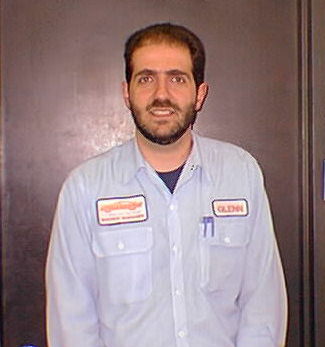 Glenn Giammalvo
Glenn Giammalvo

|

